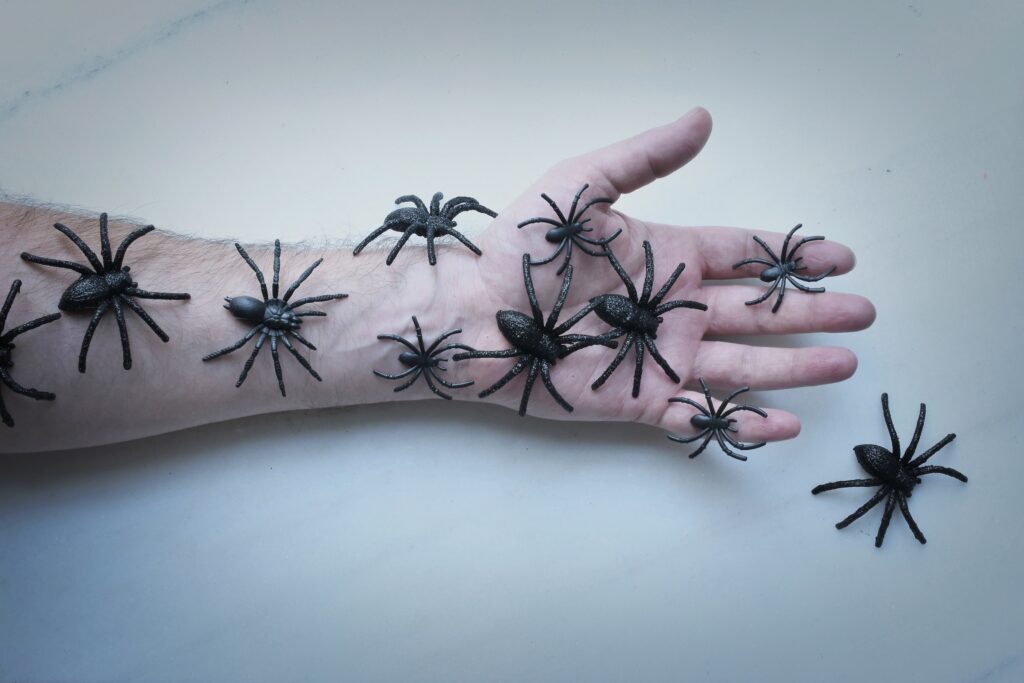We’re all familiar with phobias. But what are they, clinically speaking?
A phobia is a type of anxiety disorder where the individual experiences extreme and irrational fear of a certain situation, creature, object, place, or person.
Phobias elicit a much stronger fear response than “regular” fears and are disruptive to everyday life. Even when you’re aware the subject of your fear doesn’t pose any immediate danger, people with phobias will go out of their way to avoid the sources of their fear. This is because the effects of a phobia are more severe than discomfort or anxiety; surprise exposure can lead to panic attacks and other intense emotional responses that can lead to more serious physical or mental harm.
The Three Types of Phobias
According to the American Psychological Association, there are three types of phobias: specific phobias, social anxiety, and agoraphobia.
Specific Phobias
The majority of the phobias we recognize—e.g. spiders, heights, enclosed spaces, etc.— are specific phobias. They’re characterized by an intense, irrational fear of a specific trigger.
Also called simple phobias, specific phobias may or may not appear in everyday life as it depends on the trigger. However, doctors break specific phobias down even further into categories, which are listed below and are based on the stimulus.
- Fear of specific animals
- Fear of certain environments (e.g. heights, deep water, unhygienic situations)
- Situational phobias (e.g. visiting a doctor, flying, sailing)
- Bodily phobias (e.g. receiving an injection or cavity filling)
- Sexual phobias (e.g. performance anxiety, fear of an STD, strong aversion to touch)
Certain phobias have an evolutionary basis to aid our survival.
Some of these phobias may seem reasonable; for instance, fear of spiders or snakes can be understandable since some are venomous enough to kill a person with a bite. However, the fear becomes excessive when it extends even to spiders and snakes that are not venomous.
There are also certain phobias with an evolutionary basis, meaning that they’re meant to aid our survival. A common example of this is the fear of blood.
According to researchers, the red color of blood ensured that it was noticed quickly by our distant ancestors who lived in natural/green environments where the color red is all but impossible to miss. (In fact, this is why the color red is typically used in modern signage to denote danger.) The sight of red indicated that someone in the individual’s cohort is injured, which would increase caution and alertness to impending dangers.
But there’s a difference between healthy fear and a phobia with the latter eliciting a more extreme reaction. With a phobia, the brain disconnects reality and lets this survival instinct take over. A nosebleed isn’t life-threatening, nor is a well-trained family dog. Yet this is how someone with a phobia reacts despite recognizing the irrationality.
Social Phobias
A social phobia, also called social anxiety, ultimately comes down to a fear of public humiliation, being singled out or judged by others, or facing similar problems in a social situation. People with social anxiety struggle to function at social gatherings and in large groups. Because more people means a greater chance that something can go wrong, says the mind. This only intensifies the fear.
Agoraphobia
Similar to social phobias, people with agoraphobia often avoid social situations. However, agoraphobia is more general as it is a fear of difficult-to-escape situations. Frequently misunderstood as a fear of open spaces, agoraphobics fear potential threats from all directions and experience intense anxiety from being outside of their homes where they feel vulnerable to danger. This fear response can also happen in confined spaces like public transportation or elevators where there’s no clear escape route.
Both social phobias and agoraphobia are called “complex phobias.” While other types exist, social phobias and agoraphobia are the most common phobias of that type.
What Causes Phobias?
Like many mental health concerns, phobias can have a number of potential causes although the mechanisms behind them aren’t yet very well understood. However, research has identified a few common indicators.
Specific Trauma
A traumatizing situation at a young age can lead a person to develop a phobia of that situation later in life. For example, being stuck in a confined space as a child can lead to developing claustrophobia as an adolescent or adult.
Learned Response
When a parent is terrified of snakes or spiders, that parent’s children are likely to “acquire” that behavior, which is known as a learned behavior. In other words, if your response to a stimulus is irrational panic, then your children are likely to model that behavior as they mature.
Genetic Predisposition
Like most mental conditions, you get more than just behavior from your parents as there are genetic causes as well. This means if someone in your family suffers from phobias, then you are more likely to have phobias.
Phobias have a number of potential causes although the mechanisms behind them aren’t well understood.
How Do You Know If You Have a Phobia?
In most cases, phobias are not formally diagnosed or treated. Rather, people with phobias are aware of their issues and are independently either taking steps to avoid the trigger or to overcome their fears.
This is a reasonable reaction and not an issue on its own. However, phobias can be a huge imposition when your attempts to avoid a trigger start to interfere with everyday life and work.
While this sounds simple to identify, there are some scenarios where it might be unclear whether you’re experiencing a phobia or a regular fear. In this case, you can always review your experiences and gauge whether your symptoms are consistent with phobias.
Psychological Effects
The mental effects of a phobia are:
- Uncontrollable anxiety when exposed to the trigger
- Feeling that fear source must be avoided at all costs
- Unable to function properly when exposed to the trigger
- The knowledge that the fear is irrational, but being unable to reason it away
The last one is key: If you know you don’t need to be afraid of something, and it makes you severely anxious anyway, you probably have a phobia.
Physical Effects
The anxiety from a phobia can also manifest as physical effects, which include:
- Sweating
- Abnormal breathing
- Accelerated heartbeat
- Trembling
- Hot flashes
- Chills
- Chest pain or tightness
- Choking
- Pins and needles
- Dry mouth
- Confusion and disorientation
- Nausea
- Dizziness
- Headache
In some cases, even thinking about the phobia can be enough to cause someone with a phobia major distress.

How Do Doctors Treat Phobias?
The most popular treatment for phobias is exposure therapy. In exposure therapy, the client must confront his or her fear in a controlled, safe, and therapeutic environment. This doesn’t “cure” the psychological and physical causes of the phobia but, rather, provides new ways for the patient to cope with the fear while building up a healthy exposure over time.
Essentially, undergoing exposure therapy forces the brain to realize that the individual doesn’t have to be afraid by building up a tolerance over time. Moreover, this experience gives the individual the opportunity to forge healthy memories and have fewer negative experiences surrounding the stimulus.
This form of improved emotional processing helps build self-efficacy. It’s a way to help people with phobias realize, whether consciously or unconsciously, that they have the power to confront and overcome their fears and manage their feelings of anxiety.
Self-Exposure Therapy
While we often imagine exposure therapy as occurring in a lab setting, there are actually other types of exposure therapy too. Therapists and doctors work with their patients to choose which are suitable for the trigger and most realistic for their available resources.
In Vivo exposure
In in vivo exposure, the patient faces their fear in real life. An example of this for someone with a fear of dogs might be introducing a therapy dog into a session for a few minutes. After a few times of simply being in the same room with the dog, the client will be instructed to move closer to the animal over several sessions until the client reaches a level of comfort where he or she can pet and even cuddle with the dog.
Imaginal Exposure
Imaginal exposure works well as a way to overcome traumatic events that can’t or shouldn’t be replicated. This tends to be the best course of treatment for phobias that result from traumatic experiences. With the guidance of a therapist, the patient will recall the event that made him or her fearful of certain stimuli and then work through the situation in his or her mind.
Through exposure in controlled doses, the patient can build resilience to the phobia. The individual will regain their self-efficacy as they learn to minimize their recall of the event, allowing a return to fuller functioning.
With VR, you can trick the brain into thinking it’s confronting the individual’s fear while under supervision.
Virtual Reality Exposure
Practical concerns like cost make in vivo exposure difficult to employ for some phobias; for instance, you can’t address your fear of flying in a therapist’s office, nor can a therapist go on a plane with you. With virtual reality, you can trick the brain into thinking it’s being confronted with the individual’s fear while the patient is safely under the therapist’s supervision.
Technological developments will continue to improve this new form of not-quite-real exposure.
Interoceptive Exposure
Interoceptive exposure is about giving patients strategies with which to confront the physical sensations they fear. This occurs by inducing the somatic symptoms associated with the fear and then walking the patient through the process of appraising the threat and mitigating its effects.
Cadence of Treatment
Everyone who receives treatment for phobias has his or her own pace. For this reason, phobia treatment tends to occur at one of three different cadences: graded, flooding, and systematic desensitization.
Graded Exposure
This cadence is when the therapist starts small and works up to more serious, close, or long-lasting exposure. The idea is to help patients build tolerance over an extended period.
Flooding
Contrary to graded exposure, flooding is a lot like ripping off the band-aid in one fell swoop. With flooding, the therapist provides the most severe fear so he or she can prove that the subject isn’t actually in danger. This treatment cadence can work wonders for some people, but it can also backfire and make it worse for someone who’s not ready to confront the phobia.
Systematic Desensitization
Systematic desensitization combines exposure with relaxation and meditative exercises to help the patient manage their levels of stress and anxiety in the face of their triggers.
Medications for Phobias
Phobias are not often treated with pharmaceutical solutions although certain medications can be prescribed to curb symptoms associated with anxiety. A patient could also be prescribed antidepressants, tranquilizers, or beta-blockers to address the fear at its biological source.
Face Your Fears With Silicon Beach Behavioral Health
If you’re struggling with a phobia or other mental illness and need to find new ways to improve your mental health, Silicon Beach Behavioral Health is here for you. Located in Los Angeles, California, we provide a variety of mental health treatments for the diverse struggles people face every day.
Call our toll-free number to see how we can help you.



